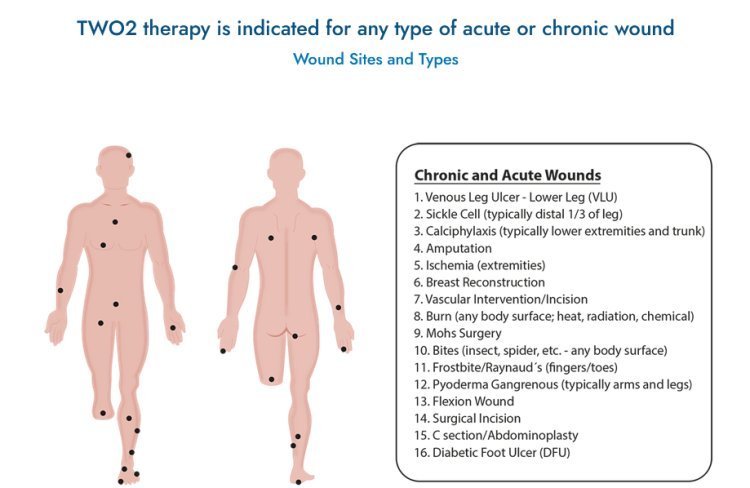Oxygen Wound Therapy: A Revolutionary Approach in Wound Care Solutions!
Oxygen wound therapy is a transformative solution in wound care, offering significant benefits for patients with chronic and non-healing wounds.

Wound care has advanced significantly over the years, driven by innovations that enhance healing and improve patient outcomes. Among these innovations, oxygen wound therapy stands out as a promising approach. This therapy leverages the healing power of oxygen to treat various wounds, including chronic ulcers. Understanding oxygen wound therapy's mechanisms, applications, and benefits can illuminate its critical role in modern wound care.
The Science behind Oxygen Wound Therapy
Oxygen is essential for cellular respiration, and energy production is critical for wound healing. In wound care, oxygen wound therapy involves delivering oxygen to the wound site to accelerate healing. Several methods are used to administer oxygen, including hyperbaric oxygen therapy (HBOT) and topical oxygen therapy (TOT).
Hyperbaric oxygen therapy involves placing patients in a pressurized chamber where they breathe pure oxygen. This increases oxygen concentration in the blood, which is then transported to the wound site. Topical oxygen therapy, on the other hand, delivers oxygen directly to the wound via a localized device or dressing. Both methods enhance oxygen availability at the wound site, promoting cellular processes essential for repair and regeneration.
Applications in Wound Care Solutions
Oxygen wound therapy is particularly effective for chronic and non-healing wounds, such as diabetic foot ulcers, pressure ulcers, and venous ulcers. These types of wounds often suffer from hypoxia, where tissues are deprived of adequate oxygen, impeding natural healing. By increasing oxygen levels, oxygen wound therapy addresses the root cause of delayed healing in these wounds.
Diabetic Foot Ulcers:
Diabetic patients often develop foot ulcers due to neuropathy and poor blood circulation. These ulcers can be stubborn, resisting traditional treatment methods. Wound care solutions can significantly improve healing rates, reduce infection risks, and potentially prevent the need for amputations.
Pressure Ulcers:
Also known as bedsores, pressure ulcers occur in patients with limited mobility, where prolonged pressure cuts off blood supply to certain areas of the skin. Oxygen therapy helps by enhancing tissue oxygenation, reducing inflammation, and promoting cell proliferation and collagen synthesis.
Venous Ulcers:
These ulcers arise from chronic venous insufficiency, where blood pools in the veins, increasing pressure and causing skin breakdown. Oxygen therapy improves oxygen delivery to the wound care ulcer, reducing edema and fostering an environment conducive to healing.
Topical Hyperbaric Oxygen: A Focused Approach
Topical hyperbaric oxygen (THBO) therapy represents a targeted approach within the broader spectrum of oxygen wound therapies. THBO involves applying oxygen directly to the wound site under slightly elevated pressures. This method allows higher oxygen concentrations at the wound surface without subjecting the entire body to hyperbaric conditions.
THBO devices typically have a sealed chamber or a specialized dressing that creates a localized hyperbaric environment. This concentrated oxygen exposure accelerates the healing process by enhancing angiogenesis (formation of new blood vessels), increasing fibroblast activity (cells that produce collagen and other fibers), and promoting the antimicrobial activity of white blood cells.
Benefits and Efficacy
Numerous clinical studies have demonstrated the efficacy of oxygen wound therapy. Patients receiving topical hyperbaric oxygen therapy for chronic wounds often experience faster healing times, reduced pain, and lower incidences of infection. The therapy's ability to enhance collagen synthesis and new blood vessel formation is critical in these positive outcomes.
Furthermore, oxygen therapy is generally well-tolerated with minimal side effects. It offers a non-invasive or minimally invasive option to optimize healing in conjunction with other wound care treatments, such as debridement, antibiotics, and traditional dressings.
Conclusion
Oxygen wound therapy is a transformative solution in wound care, offering significant benefits for patients with chronic and non-healing wounds. By leveraging the healing power of oxygen through methods like hyperbaric oxygen therapy and topical hyperbaric oxygen, healthcare providers can improve patient outcomes, reduce healthcare costs, and enhance quality of life. As research continues and technology advances, oxygen wound therapy is poised to become integral to comprehensive wound care strategies, offering hope and healing to millions of patients worldwide.
What's Your Reaction?










![Blog Submission Sites 2024 [High DA]](https://blognow.co.in/uploads/images/202306/image_100x75_6494a03eaff5e.jpg)
![Article Submission Sites 2023 [High DA & PA]](https://blognow.co.in/uploads/images/202307/image_100x75_64c4181f17036.jpg)
![Classified Submission Sites 2023 [High DA & PR]](https://blognow.co.in/uploads/images/202306/image_100x75_649dcd5260808.jpg)




![Article Submission Sites 2023 [High DA & PA]](https://blognow.co.in/uploads/images/202307/image_750x415_64c4181f08ed5.jpg)
![Classified Submission Sites 2023 [High DA & PR]](https://blognow.co.in/uploads/images/202306/image_750x415_649dcd5247eeb.jpg)
![Blog Submission Sites 2024 [High DA]](https://blognow.co.in/uploads/images/202306/image_750x415_6494a03e96bfa.jpg)